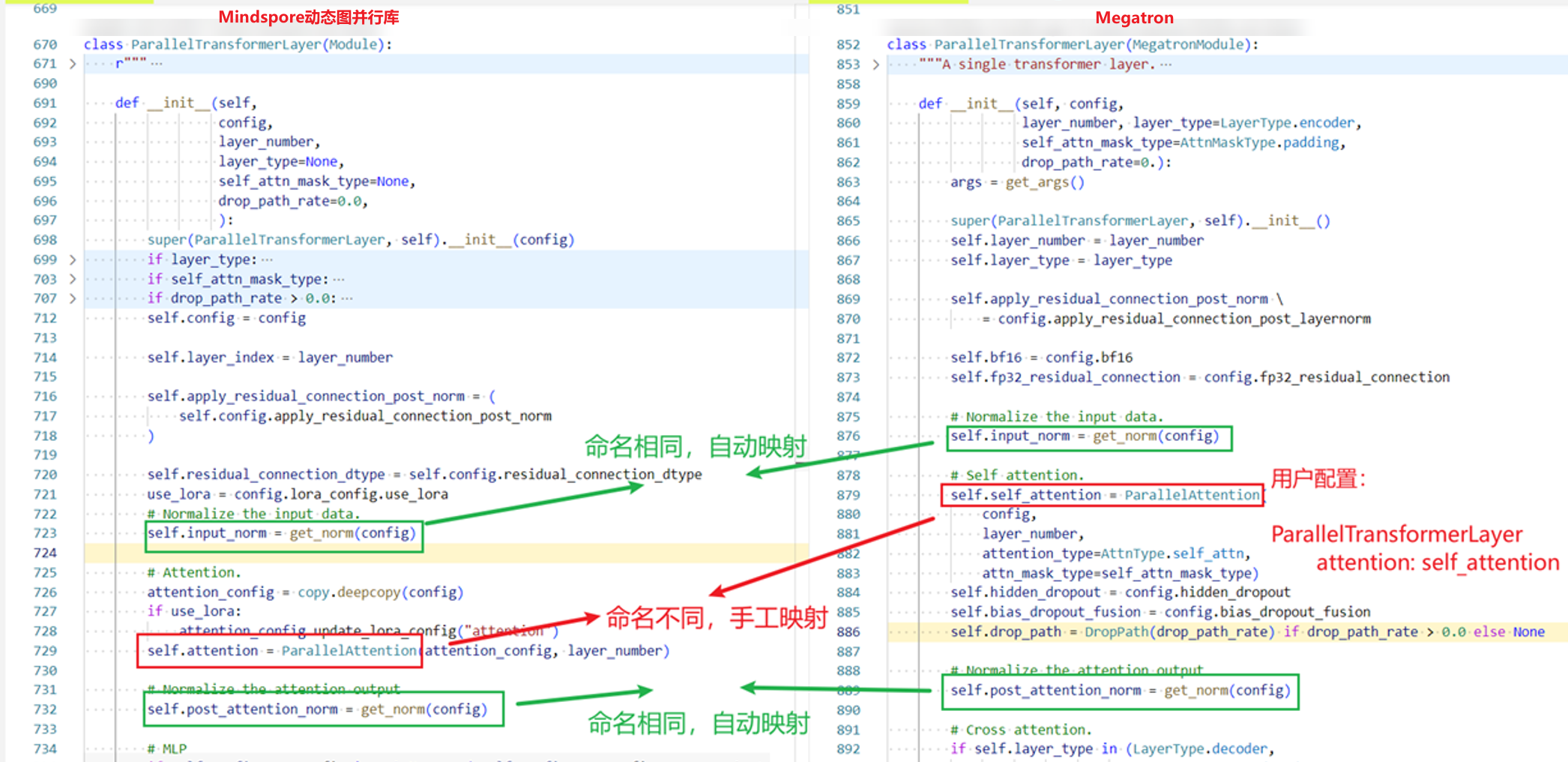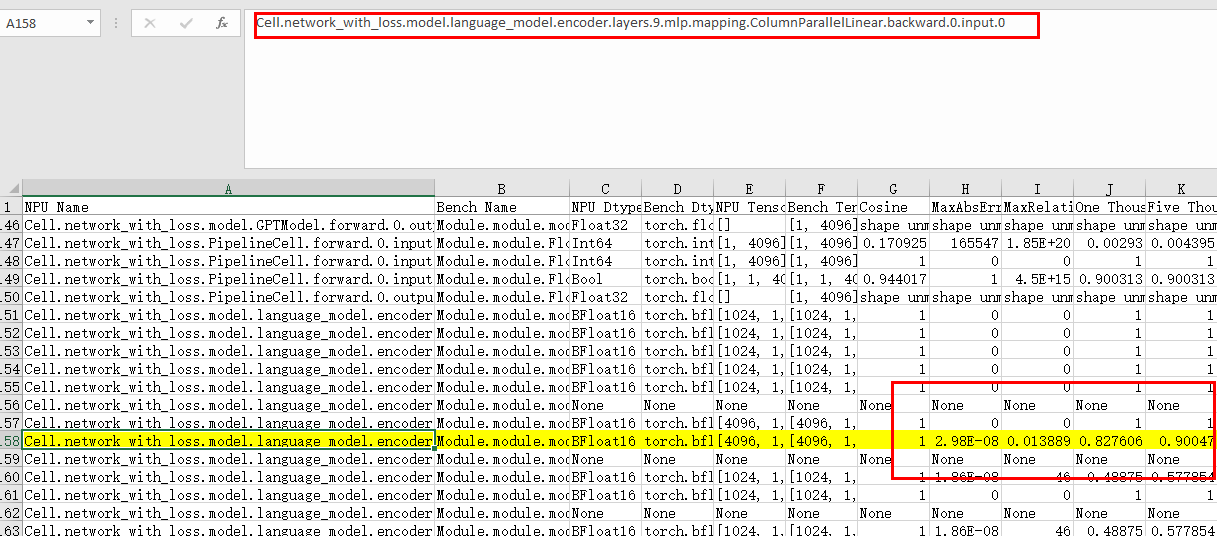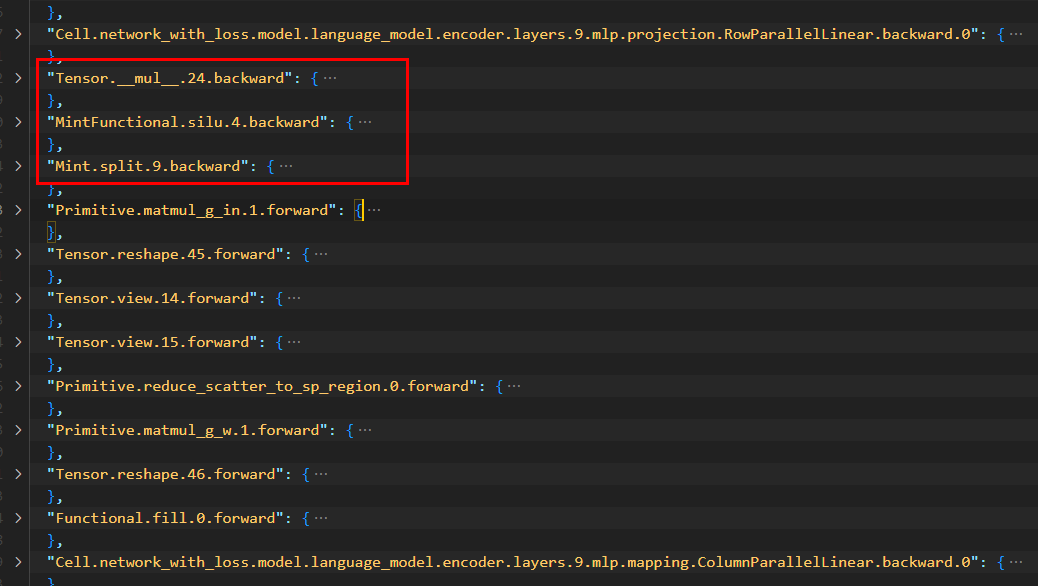动态图场景精度调优工具及案例
精度问题概述和场景
详细介绍请参考精度问题概述及场景章节。
精度问题定位CheckList
在定位算子精度问题之前,首先要排除其他非算子因素的干扰。结合以往精度定位案例,总结了精度定位前的CheckList。为了在定位过程中少走弯路,用户可先根据CheckList进行快速的排查。详细CheckList请参考精度问题定位CheckList章节。
精度定位通用流程
精度定位通用流程请参考精度定位通用流程章节。
大模型迁移精度标准
大模型迁移精度标准请参考大模型迁移精度标准章节,该标准仅作为参考。
msprobe工具介绍
msprobe 是 MindStudio Training Tools 工具链下精度调试部分的工具包,主要适用于MindSpore动态图场景的精度问题定位。安装过程请参考工具安装文档, 主要包括以下几个功能:
功能 |
简要说明 |
详细说明 |
|---|---|---|
数据采集 |
msprobe 工具通过在训练脚本内添加 dump 接口、启动训练的方式采集网络中API或模块的输入输出数据。 |
|
精度比对 |
msprobe 工具可以对采集下来的数据,进行精度比对。 |
|
精度预检 |
MindSpore 动态图精度预检通过扫描昇腾 NPU 上用户训练 MindSpore 模型中的所有 mint API以及部分 Tensor API,输出精度情况的诊断和分析。工具以模型中所有 mint API 前反向的 dump 结果为输入,构造相应的 API 单元测试,将 NPU 输出与标杆(CPU 高精度)比对,计算对应的精度指标,从而找出 NPU 中存在精度问题的 mint API。 |
|
溢出检测 |
msprobe 工具提供溢出检测功能,针对网络中的每一个API进行输出数据的溢出检测。 |
|
梯度状态监测 |
采集梯度数据并进行梯度相似度比对,可以精准定位出现问题的 step。 |
以下将以两个常用的功能 精度比对 和 精度预检 为例,介绍 msprobe 工具使用的基本流程。
精度比对定位案例
总体定位流程
首先针对MindSpore实现的模型和PyTorch实现的模型进行数据dump,由于两侧代码在API粒度上可能无法完全对齐,因此可以先使用模块级数据dump,进行模块粒度的比对分析。
根据模块级数据的比对结果,找到第一个精度无法对齐的模块,对模块进行更细粒度的API级别数据dump。
对展开后的模块内部数据进行比对分析,确认问题点。
详细步骤
工具配置
配置config.json文件:"level"为"L0", 代表为模块级别数据dump, "task"为"tensor"代表采集真实数据。"step" 指定为第1个step(从0开始计数),配置文件字段详见配置文件介绍。
tensor模式(保存统计信息和真实数据,需较大磁盘空间)如下:
{ "task": "tensor", "dump_path": "/path/to/dump/data", "rank": [], "step": [0], "level": "L0", "tensor":{ "scope": [], "list": [], "data_mode": ["all"] } }
统计信息md5模式(保存统计信息以及md5值,需要比较二进制一致场景推荐使用)如下:
{ "task": "statistics", "dump_path": "/path/to/dump/data", "rank": [], "step": [0], "level": "L0", "statistics":{ "scope": [], "list": [], "data_mode": ["all"], "summary_mode": "md5" } }
训练代码配置
找到网络模型的训练代码(需要找到训练迭代循环的train方法),在训练循环中插入工具的dump接口使能数据dump。
# 首先导入msprobe工具的PrecisionDebugger类 from msprobe.mindspore import PrecisionDebugger # 实例化PrecisionDebugger类,并传入config.json文件路径 debugger = PrecisionDebugger(config_path="/path/to/config.json") ... ... ... net = Net() # 在训练循环中,插入工具的dump代码 def train(net): ... for data in dataset: # 开启数据dump, start中传入实例化的网络模型 debugger.start(net) output = net(data) ... # 结束数据dump debugger.stop() # 更新迭代step数 debugger.step()
启动训练
训练结束后查看dump数据,dump数据保存在config.json中的dump_path字段路径中,dump结果中包括以下文件:
dump.json: 其中包括所有数据的基本信息以及统计信息。示例如下:{ "task": "tensor", "level": "L0", "dump_data_dir": "/home/dump_file/tensor_ms_L0/step0/rank0/dump_tensor_data", "data": { "Cell.model.language_model.embedding.word_embeddings.reduce_scatter_to_sp_region.ReduceScatterToSequenceParallelRegion.forward.0": { "input_args": [ { "type": "mindspore.Tensor", "dtype": "BFloat16", "shape": [ 4096, 1, 8192 ], "Max": 2.46875, "Min": -2.765625, "Mean": -0.0001125335693359375, "Norm": 2704.0, "data_name": "Cell.model.language_model.embedding.word_embeddings.reduce_scatter_to_sp_region.ReduceScatterToSequenceParallelRegion.forward.0.input.0.npy" } ], "input_kwargs": {}, "output": [ { "type": "mindspore.Tensor", "dtype": "BFloat16", "shape": [ 1024, 1, 8192 ], "Max": 2.46875, "Min": -2.515625, "Mean": -0.00020885467529296875, "Norm": 1448.0, "data_name": "Cell.model.language_model.embedding.word_embeddings.reduce_scatter_to_sp_region.ReduceScatterToSequenceParallelRegion.forward.0.output.0.npy" } ] } } }
stack.json: 包括所有前向数据的调用栈信息,可以将数据关联到对应代码行。示例如下:
{ "Cell.model.language_model.embedding.word_embeddings.reduce_scatter_to_sp_region.ReduceScatterToSequenceParallelRegion.forward.0": [ "File /home/python3.9/site-packages/mindspore/nn/cell.py, line 507, in _run_construct, \n output = self._run_forward_hook(inputs, output)", "File /home/python3.9/site-packages/mindspore/nn/cell.py, line 759, in _complex_call, \n output = self._run_construct(*args, **kwargs)", "File /home/python3.9/site-packages/mindspore/nn/cell.py, line 747, in __call__, \n return self._complex_call(*args, **kwargs)", "File /home/mindformers/experimental/distri_cores/tensor_parallel/layers.py, line 770, in construct, \n output = self.reduce_scatter_to_sp_region(output_parallel)", "File /home/python3.9/site-packages/mindspore/nn/cell.py, line 2462, in _backward_hook_construct, \n outputs = self.construct(outputs, **kwargs)", "File /home/python3.9/site-packages/mindspore/nn/cell.py, line 498, in _run_construct, \n output = self._backward_hook_construct(*inputs, **kwargs)", "File /home/python3.9/site-packages/mindspore/nn/cell.py, line 745, in __call__, \n return self._run_construct(*args, **kwargs)", "File /home/mindformers/experimental/distri_cores/transformer/language_model.py, line 151, in construct, \n embeddings = self.word_embeddings(input_ids)", "File /home/python3.9/site-packages/mindspore/nn/cell.py, line 2460, in _backward_hook_construct, \n outputs = self.construct(*outputs, **kwargs)", "File /home/python3.9/site-packages/mindspore/nn/cell.py, line 498, in _run_construct, \n output = self._backward_hook_construct(*inputs, **kwargs)", "File /home/python3.9/site-packages/mindspore/nn/cell.py, line 745, in __call__, \n return self._run_construct(*args, **kwargs)", "File /home/mindformers/experimental/distri_cores/transformer/language_model.py, line 391, in construct, \n text_embedding_out = self.embedding(enc_input_ids, enc_position_ids,", "File /home/python3.9/site-packages/mindspore/nn/cell.py, line 2460, in _backward_hook_construct, \n outputs = self.construct(*outputs, **kwargs)", "File /home/python3.9/site-packages/mindspore/nn/cell.py, line 498, in _run_construct, \n output = self._backward_hook_construct(*inputs, **kwargs)", "File /home/python3.9/site-packages/mindspore/nn/cell.py, line 745, in __call__, \n return self._run_construct(*args, **kwargs)", "File /home/model/gpt_model.py, line 104, in construct, \n lm_output = self.language_model(tokens,", "File /home/python3.9/site-packages/mindspore/nn/cell.py, line 2460, in _backward_hook_construct, \n outputs = self.construct(*outputs, **kwargs)", "File /home/python3.9/site-packages/mindspore/nn/cell.py, line 498, in _run_construct, \n output = self._backward_hook_construct(*inputs, **kwargs)", "File /home/python3.9/site-packages/mindspore/nn/cell.py, line 745, in __call__, \n return self._run_construct(*args, **kwargs)", "File /home/mindformers/experimental/distri_cores/pipeline_parallel/pipeline_cell.py, line 429, in construct, \n return self.model(*inputs)", "File /home/python3.9/site-packages/mindspore/nn/cell.py, line 757, in _complex_call, \n output = self.construct(*args, **kwargs)", "File /home/python3.9/site-packages/mindspore/nn/cell.py, line 747, in __call__, \n return self._complex_call(*args, **kwargs)", "File /home/mindformers/experimental/distri_cores/pipeline_parallel/schedules.py, line 121, in run_forward, \n output_tensor = model(*input_data, recv_data=None)", "File /home//mindformers/experimental/distri_cores/pipeline_parallel/schedules.py, line 735, in forward_backward_pipelining_without_interleaving, \n micro_input_data = run_forward(*micro_input_data,", "File /home/mindformers/experimental/distri_cores/training.py, line 409, in forward_backward_with_pipelining, \n loss, logits, grads = forward_backward_pipelining_without_interleaving(", "File /home/mindformers/experimental/distri_cores/training.py, line 533, in construct, \n (loss, _), grads = self.forward_backward_func(*inputs_tuple, loss_scale=current_step_loss_scale, **inputs_dict)", "File /home/python3.9/site-packages/mindspore/nn/cell.py, line 757, in _complex_call, \n output = self.construct(*args, **kwargs)", "File /home/python3.9/site-packages/mindspore/nn/cell.py, line 747, in __call__, \n return self._complex_call(*args, **kwargs)", "File /home/mindformers/experimental/distri_cores/training.py, line 655, in train, \n loss, is_finite, loss_scale, learning_rate = train_one_step_cell(**data)", "File /home/model/pretrain_gpt.py, line 303, in main, \n train(", "File /home/model/pretrain_gpt.py, line 316, in <module>, \n main()" ] }
construct.json: 包括模型的结构信息,记录每个模块或API的父模块 ("level"为"L1"时,该文件内容为空)。 示例如下:
{ "Cell.model.language_model.embedding.word_embeddings.reduce_scatter_to_sp_region.ReduceScatterToSequenceParallelRegion.forward.0": "Cell.model.language_model.embedding.word_embeddings.VocabParallelEmbedding.forward.0", "Cell.model.GPTModel.forward.0": null, "Cell.model.language_model.TransformerLanguageModel.forward.0": "Cell.model.GPTModel.forward.0", "Cell.model.language_model.embedding.Embedding.forward.0": "Cell.model.language_model.TransformerLanguageModel.forward.0", "Cell.model.language_model.embedding.word_embeddings.VocabParallelEmbedding.forward.0": "Cell.model.language_model.embedding.Embedding.forward.0", "Cell.model.language_model.rotary_pos_emb.RotaryEmbedding.forward.0": "Cell.model.language_model.TransformerLanguageModel.forward.0", "Cell.model.language_model.encoder.layers.0.input_norm.FusedRMSNorm.forward.0": "Cell.model.language_model.encoder.layers.0.ParallelTransformerLayer.forward.0", "Cell.model.language_model.encoder.ParallelTransformer.forward.0": "Cell.model.language_model.TransformerLanguageModel.forward.0", "Cell.model.language_model.encoder.layers.0.ParallelTransformerLayer.forward.0": "Cell.model.language_model.encoder.ParallelTransformer.forward.0", "Cell.model.language_model.encoder.layers.0.attention.qkv_proj.forward_impl_.LinearWithGradAccumulationAndAsyncCommunication.forward.0": "Cell.model.language_model.encoder.layers.0.attention.qkv_proj.ColumnParallelLinear.forward.0", "Cell.model.language_model.encoder.layers.0.attention.ParallelAttention.forward.0": "Cell.model.language_model.encoder.layers.0.ParallelTransformerLayer.forward.0", "Cell.model.language_model.encoder.layers.0.attention.qkv_proj.ColumnParallelLinear.forward.0": "Cell.model.language_model.encoder.layers.0.attention.ParallelAttention.forward.0", "Cell.model.language_model.encoder.layers.0.attention.out_proj.forward_impl_.LinearWithGradAccumulationAndAsyncCommunication.forward.0": "Cell.model.language_model.encoder.layers.0.attention.out_proj.RowParallelLinear.forward.0", "Cell.model.language_model.encoder.layers.0.attention.out_proj.RowParallelLinear.forward.0": "Cell.model.language_model.encoder.layers.0.attention.ParallelAttention.forward.0", "Cell.model.language_model.encoder.layers.0.attention.out_proj.reduce_scatter_to_sp_region.ReduceScatterToSequenceParallelRegion.forward.0": "Cell.model.language_model.encoder.layers.0.attention.out_proj.RowParallelLinear.forward.0", "Cell.model.language_model.encoder.layers.0.attn_post_norm.FusedRMSNorm.forward.0": "Cell.model.language_model.encoder.layers.0.ParallelTransformerLayer.forward.0", "Cell.model.language_model.encoder.layers.0.hidden_states_dropout.DropoutExt.forward.0": "Cell.model.language_model.encoder.layers.0.ParallelTransformerLayer.forward.0", "Cell.model.language_model.encoder.layers.0.post_attention_norm.FusedRMSNorm.forward.0": "Cell.model.language_model.encoder.layers.0.ParallelTransformerLayer.forward.0", "Cell.model.language_model.encoder.layers.0.mlp.mapping.forward_impl_.LinearWithGradAccumulationAndAsyncCommunication.forward.0": "Cell.model.language_model.encoder.layers.0.mlp.mapping.ColumnParallelLinear.forward.0", "Cell.model.language_model.encoder.layers.0.mlp.ParallelMLP.forward.0": "Cell.model.language_model.encoder.layers.0.ParallelTransformerLayer.forward.0", "Cell.model.language_model.encoder.layers.0.mlp.mapping.ColumnParallelLinear.forward.0": "Cell.model.language_model.encoder.layers.0.mlp.ParallelMLP.forward.0", "Cell.model.language_model.encoder.layers.0.mlp.projection.forward_impl_.LinearWithGradAccumulationAndAsyncCommunication.forward.0": "Cell.model.language_model.encoder.layers.0.mlp.projection.RowParallelLinear.forward.0", "Cell.model.language_model.encoder.layers.0.mlp.projection.RowParallelLinear.forward.0": "Cell.model.language_model.encoder.layers.0.mlp.ParallelMLP.forward.0", "Cell.model.language_model.encoder.layers.0.mlp.projection.reduce_scatter_to_sp_region.ReduceScatterToSequenceParallelRegion.forward.0": "Cell.model.language_model.encoder.layers.0.mlp.projection.RowParallelLinear.forward.0", "Cell.model.language_model.encoder.layers.0.ffn_post_norm.FusedRMSNorm.forward.0": "Cell.model.language_model.encoder.layers.0.ParallelTransformerLayer.forward.0", "Cell.model.language_model.encoder.layers.0.hidden_states_dropout.DropoutExt.forward.1": "Cell.model.language_model.encoder.layers.0.ParallelTransformerLayer.forward.0", "Cell.model.language_model.encoder.layers.1.input_norm.FusedRMSNorm.forward.0": "Cell.model.language_model.encoder.layers.1.ParallelTransformerLayer.forward.0", "Cell.model.language_model.encoder.layers.1.ParallelTransformerLayer.forward.0": "Cell.model.language_model.encoder.ParallelTransformer.forward.0", }
dump_tensor_data: 包括所有数据的npy文件(只在task为“tensor”时存在),完整目录结构如下:
├── dump_path │ ├── step0 │ | ├── rank0 │ | │ ├── dump_tensor_data | | | | ├── Cell.model.language_model.embedding.word_embeddings.reduce_scatter_to_sp_region.ReduceScatterToSequenceParallelRegion.forward.0.output.0.npy | | | | ... | | | | └── Cell.model.language_model.embedding.word_embeddings.reduce_scatter_to_sp_region.ReduceScatterToSequenceParallelRegion.forward.0.input.0.npy │ | | ├── dump.json │ | | ├── stack.json │ | | └── construct.json │ | ├── rank1 | | | ├── dump_tensor_data | | | | └── ... │ | | ├── dump.json │ | | ├── stack.json | | | └── construct.json │ | ├── ... │ | | | | └── rank7 │ ├── step1 │ | ├── ... │ ├── step2
精度比对
将dump得到的MindSpore侧数据与PyTorch侧数据进行精度比对。首先配置compare.json文件,示例如下:
{ "npu_path": "/home/dump_file/tensor_l0_ms/step0/rank0/dump.json", "bench_path": "/home/dump_file/tensor_l0_pt/step0/rank0/dump.json", "stack_path": "/home/dump_file/tensor_l0_ms/step0/rank0/stack.json", "is_print_compare_log": true }
npu_path为MindSpore侧的dump.json文件路径, bench_path为PyTorch侧的dump.json文件路径, stack_path为MindSpore侧的stack.json文件路径。
运行比对命令
详细比对相关命令介绍可参考精度比对使用说明。 当前场景使用跨框架Cell级别比对,需要在比对时使用层映射功能,传入层映射文件, 执行以下命令msprobe -f mindspore compare -i ./compare.json -o ./output -lm ./layer_mapping.yaml
参数说明
参数名
说明
是否必选
-i或–input_path
compare.json文件路径。
是
-o或–output_path
配置比对结果文件存盘目录,默认会在当前目录创建output目录。
否
-lm或–layer_mapping
跨框架比对。配置该参数时表示开启跨框架Layer层的比对功能,指定模型代码中的Layer层后,可以识别对应dump数据中的模块或API。需要指定自定义映射文件*.yaml。自定义映射文件可从MindSpore动态图并行库中获取,也可以参考下方示例自行配置,仅跨框架的Layer层比对场景需要配置。
否
layer_mapping.yaml 映射文件内容可参考如下示例:
TopLayer: # Layer层名称 network_with_loss: module # 冒号左侧为MindSpore框架模型代码中嵌套的Layer层名称,冒号右侧为PyTorch框架模型代码中嵌套的Layer层名称 Embedding: dropout: embedding_dropout ParallelTransformerLayer: attention: self_attention ParallelAttention: qkv_proj: query_key_value out_proj: dense ParallelMLP: mapping: dense_h_to_4h projection: dense_4h_to_h
Layer层名称需要从模型代码中获取。 映射文件中只需配置MindSpore与PyTorch模型代码中功能一致但名称不同的Layer层,名称相同的Layer层会被自动识别并映射。

分析比对结果
在输出目录查看比对结果的csv文件: 查看表格后发现第一个产生误差的位置为Cell.network_with_loss.model.language_model.encoder.layers.9.mlp.mapping.ColumnParallelLinear.backward.0.input.0,从命名中可以看出这个模块的反向的输入存在精度问题,而上一个模块的反向输出没有精度问题,因此怀疑在这两个模块之间的某些计算存在精度问题。
查看表格后发现第一个产生误差的位置为Cell.network_with_loss.model.language_model.encoder.layers.9.mlp.mapping.ColumnParallelLinear.backward.0.input.0,从命名中可以看出这个模块的反向的输入存在精度问题,而上一个模块的反向输出没有精度问题,因此怀疑在这两个模块之间的某些计算存在精度问题。细粒度数据采集与分析 通过上一步的表格分析,我们将精度问题出现的区间锁定在了Cell.network_with_loss.model.language_model.encoder.layers.9.mlp.projection.RowParallelLinear.backward.0.output.0 和 Cell.network_with_loss.model.language_model.encoder.layers.9.mlp.mapping.ColumnParallelLinear.backward.0.input.0 之间。因此我们继续dump这两个模块之间的所有API级别数据,来继续定位。此时将config.json文件中的“level”字段配置为“mix”(代表同时dump模块级以及API级数据),并在“scope”中配置上述两个模块的名字用于锁定区间。
{ "task":"tensor", "dump_path": "./tensor_mix_ms", "rank": [], "step": [0], "level": "mix", "tensor": { "scope": ["Cell.network_with_loss.model.language_model.encoder.layers.9.mlp.projection.RowParallelLinear.backward.0", "Cell.network_with_loss.model.language_model.encoder.layers.9.mlp.mapping.ColumnParallelLinear.backward.0"], "list":[], "data_mode": ["all"] } }由于我们已经锁定了区间,因此dump数据个数并不多,先分别查看MindSpore侧的dump.json文件和PyTorch侧的dump.json文件进行分析。
MindSpore:

PyTorch:

通过查看json文件我们发现在这两个模块间的反向计算中,MindSpore侧对于swiglu的实现是通过手动实现的3个API拼接而成,而PyTorch侧的swiglu则直接使用了融合API,直接调用了npu_swiglu进行计算,因此怀疑两边可能会存在精度误差。随后将PyTorch侧的融合api改写成相同api拼接计算,发现精度问题消失。
msprobe工具精度预检案例
数据采集
首先需要使用数据采集功能将网络中所有的API采集出来,若将"task"配置为"tensor"采集,在预检进行单元测试时就会使用真实数据输入。若将"task"配置为"statistics"采集,则单元测试时会随机生成数据输入,"level"需设置为"L1"代表进行API级别dump。
{
"task":"tensor",
"dump_path": "./tensor_l1_ms",
"rank": [],
"step": [0],
"level": "L1",
"tensor": {
"scope": [],
"list":[],
"data_mode": ["all"]
}
}
精度预检 (只支持mint API和部分Tensor API)
使用msprobe工具进行精度预检,命令如下:
msprobe -f mindspore run_ut -api_info ./tensor_l1_ms/step0/rank0/dump.json -o ./output
精度预检结果分析
预检执行结果包括 accuracy_checking_result_{timestamp}.csv 和 accuracy_checking_details_{timestamp}.csv 两个文件。accuracy_checking_result_{timestamp}.csv 属于 API 级,标明每个 API 是否通过测试。建议用户先查看 accuracy_checking_result_{timestamp}.csv 文件,对于其中没有通过测试的或者特定感兴趣的 API,根据其 API Name 字段在 accuracy_checking_details_{timestamp}.csv 中查询其各个输出的达标情况以及比较指标。通过分析具体指标来定位到底哪些 API 存在精度问题,详细介绍请参见预检结果说明。
预检结果示例:

上图中的Status字段表示API是否通过测试,通过测试的API的Status字段为"pass",不通过测试的API的Status字段为"error"。当余弦相似度大于0.99,并且最大绝对误差小于0.0001时,API的Status字段为"pass",否则为"error"。通过精度预检可以发现相同的API在MindSpore和PyTorch的精度表现是否存在差异,以及差异的大小,从而定位到哪些API可能存在精度问题,并进一步分析产生精度差异的原因。